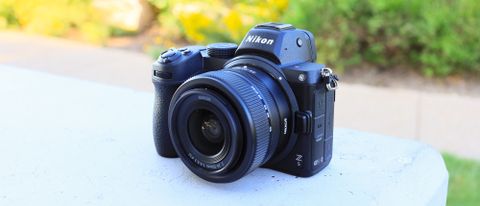Tom's Guide Verdict
An entry-level full-frame mirrorless camera that’s just as well suited to many professionals as experienced amateurs, the Nikon Z5 is easy to use while still offering all the manual features and customized settings you’d expect from a camera in this price bracket.
Pros
- +
Comfortable Grip
- +
Large LCD screen
- +
Double SD card slots
- +
Easy-to-change settings via on-body buttons
- +
Weather sealed
Cons
- -
Tilt screen, but no flip screen
- -
No built-in flash
- -
Cropped 4K video
- -
Only 4.5 frames per second in burst shooting mode
Why you can trust Tom's Guide
Size: 5.3 x 4.0 x 2.8 in.
Weight: 20.9 oz. (body only)
Sensor: full frame, 35.9 x 23.9 mm
ISO range: 100 - 51,200 (expandable to ISO 102,400)
Display: 3.2 in. diagonal
Shooting speed: 4.5 fps
AF: 273 (single-point AF)
Ports: Microphone, headphone, HDMI, USB-C, accessory terminal
Memory card slots: 2
An entry-level full-frame mirrorless camera that’s just as well suited to many professionals as experienced amateurs, the Nikon Z5 is easy to use while still offering all the manual features and customized settings you’d expect from a camera in this price bracket.
Its 24MP sensor takes beautiful photos, and is compact without being uncomfortable for long days of hand-held shooting.
Read why we think this is one of the best mirrorless cameras in our Nikon Z5 review.
Nikon Z5 review: Price and Availability
The Nikon Z5 has been available since July, 2020, with or without one of two kit lenses: the underwhelming NIKKOR Z 24-50mm f/4–6.3 or NIKKOR Z 24-200mm f/4-6.3 VR. The camera is designed to work with Nikon’s Z-mount lenses, but experienced Nikon users who may already have a shelf full of Nikon’s traditional F-mount lenses (designed for use with the brand’s DSLR cameras) can still use those lenses by utilizing Nikon’s F-mount adapter.
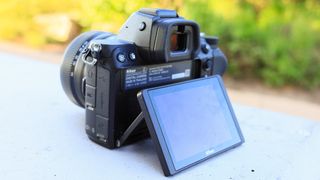
The body on its own starts at $1,399 and goes up to $1,699 for a kit with the 24-50 F4-6.3 lens and $2199 with the 24-200 F4-6.3 VR (vibration reduction).
Nikon Z5 review: Design
Just a bit bulkier than some of the other cameras in its class (like the Canon RP and Sony A7iii) the Nikon Z5 measures 5.3 x 4 x 2.8 inches and weighs a moderate 20.9 ounces. That’s the same size and weight as its slightly more advanced sibling, the Nikon Z6.
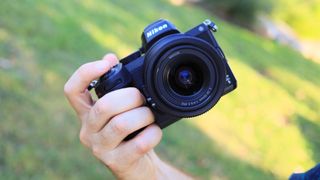
There’s a nice big 3.2-inch LCD monitor on the back of the camera, which makes composing shots and using the touchscreen to adjust settings and focus quick and easy. But while the monitor does pop away from the camera body to tilt up and down (vari-tilt), it doesn’t flip or rotate.
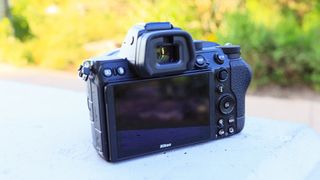
Not only does that make composing extreme angle shots and self portraits more difficult, but it also means the screen can’t be folded inward to protect the screen from scratches and smudges when stored in your camera bag or carried around town.
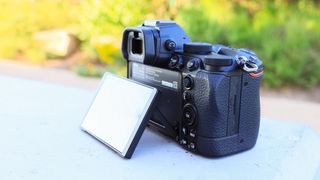
I’ve found a fully adjustable vari-angle LCD like that of the Canon RP to be supremely useful when shooting with small, light mirrorless cameras and truly missed it when shooting with the Z5.
Nikon Z5 review: Ease of Use
Right off the bat, I liked the Z5’s deep grip, which isn’t always found on mirrorless cameras. It offered a very comfortable and secure hand-hold.
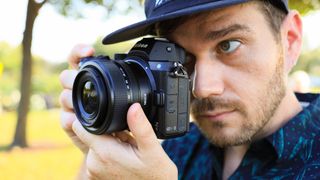
Likewise, I appreciated how far the viewfinder extended from the back of the camera, which creates enough space between your face and the LCD so that face oils don’t build up on the monitor and your cheek is less likely to bump it and change settings or focus points on the touchscreen.
And while the camera menu is vast (yet quicker and easier to navigate than Canon menus tend to be), almost all of the settings you’ll regularly want to access and change are available via the i button or other dedicated buttons on the outside of the camera. One I found especially handy was the monitor mode button on the left side of the viewfinder that let me quickly and easily switch between the four different viewfinder/LCD screen viewing modes (viewfinder only, LCD only, viewfinder-preferred, viewfinder sensor).
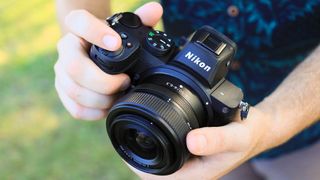
As for the dials and controls, they’re all very accessible and fairly easy-to-use while shooting. I found most of them more intuitive than those on the Canon RP. The only minor exceptions are the ISO, Fn1 and Fn2 buttons, which you have to hold down while simultaneously turning the main command dial in order to adjust settings while you’re shooting. It’s a little awkward, but no deal breaker, and will likely become second-nature with use.
As for the LCD touch screen, it was responsive and easy to use, including when selecting focus points. Prefer not to use the touchscreen? A simple tap is all that’s required to turn it off and on.
Nikon Z5 review: Image Quality and Low Light Performance
Image quality from the Z5 is very good, even if the full-frame sensor isn’t as up-to-date as the one in the Z6. Color was bright, clean and realistic and images were crisp and clear. Colors were true and skin tones were accurate (if not quite as creamy as those the Canon RP delivers). But details like leaves, hair, and textures were always captured with good contrast and overall the camera captured a solid dynamic range.

White balance settings include a custom preset and natural light auto, plus the ability to customize the auto white balance setting to reduce or maintain warm tones to further ensure the camera captures perfect color every time.

In-camera image stabilization helps keep camera shake at bay at slower shutter speeds to help ensure sharper photos and ISO sensitivity goes up to 51200 (expandable to ISO 102,400), but you start to lose detail and see a significant amount of noise around 25600. Fortunately, even on auto settings, you can set an upper limit for ISO to keep noise within manageable levels.



As for flash, there is no on-body pop-up flash, which is becoming standard for many full-frame mirrorless cameras, but may make it less desirable for a true entry-level consumer.
Nikon Z5 review: Video Quality
The Nikon Z5 shoots 4K Ultra HD/30p plus 1080/60p footage, but it is cropped, so that’s a bit of a drawback if you shoot a lot of video. But the Z5 is easy to shoot with and the in-camera image stabilization is helpful for hand-held shots. It also has a mic and a headphone jack so you can ensure the audio you capture is clean. However, there’s a bit of aliasing that occurs on-screen when shooting due to the crop and compression, so it’s occasionally hard to assess video quality and proper exposure from looking at the LCD.

On the upside, you can capture stills while you’re recording videos, which you can’t do with the Canon RP, and the Nikon Z5 also offers the ability to create timelapse movies in-camera, which is fairly novel. And, as many newer mirrorless cameras are offering these days, the Z5 can be used for live-streaming when connected to your computer.
That said, the Z5 is clearly a stills-first camera with the added benefit of shooting video. Those who tend to focus on video over stills will likely find the video function adequate at best, and should check out the Sony Alpha a6600 instead.
Nikon Z5 review: Performance
When it comes to auto-focus, there are 273 focus points covering 90% of the frame (the camera uses a hybrid phase-detection/contrast AF with AF assist) that let you focus on virtually any part of the frame. You can even select the size of the autofocus area via the autofocus menu, from pinpoint focus to autofocus selection across the entire frame.
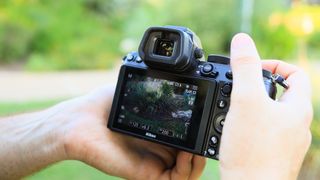
There’s also face detection, which works so well that I had to turn it off while shooting photos of products when there were faces in the background; the camera didn’t want to focus on the inanimate objects in the foreground. Eye detection works well, too. The Z5 was able to lock onto a subject’s eye even when there was a lot of other detail and clutter in the frame.

The animal detection autofocus feature, to my surprise, functioned as intended, locking onto a moving dog’s face and eyes better than the regular face and eye detection. Don’t have a dog? The feature also works with cats, but those are the only two animals Nikon specifies animal detection will work with.
Another welcome feature: Two SD card slots can be used for overflow storage, automatic back up, or separating file types like RAW and JPEG or stills and videos. So for those worried about running out of space on their cards, losing photos without redundant backups, or who simply prefer to keep file types separate, those dual slots are a godsend. For day-to-day shooting, however, many users will likely find this feature unnecessary.
One area where the Nikon Z5 gets a ding, though, is in burst mode. It only shoots 4.5 frames per second, which may be plenty for some, but for those shooting sports or action where milliseconds can mean the difference between an adequate capture and an excellent one, 4.5 fps is a bit sluggish, especially compared to the Z6’s 12 fps.
Nikon Z5 review: Battery life
The Z5 is fairly long-lasting for a mirrorless camera. Nikon says the Z5 will last up to 470 shots (using monitor only) or 120 minutes of movie recording, and I found that after a weekend of intermittent shooting, mostly using the automatic eye sensor, I had only used about half of the battery life. The battery life certainly out-performs the Canon RP, which lasts a mere 250 shots. One helpful detail: the menu offers the ability to see what percentage of battery life/shots remain before you’ll need to recharge.
Nikon Z5 review: Verdict
Overall, the Nikon Z5 is a quality full-frame camera that’s easy to use. Almost all the settings can be easily adjusted from either the i menu or a dedicated button on the camera body and it’s compact while still being comfortable to hold. Photo quality is excellent, and while the video capabilities leave something to be desired when compared to some other cameras in its class, most users will find it still creates suitably attractive videos.
The large, touch-sensitive LCD is a dream, but the inability to flip and swivel the monitor is unfortunate. The weather-sealing is a welcome detail, though. Those who plan to shoot more video than still photos should check out the Sony Alpha a6600, which lacks a full-frame sensor but has 5-axis in body stabilization, 4K video, and headphone and mic jacks. But, with features such as dual card slots, a full-frame sensor and full manual controls, the Nikon Z5 is an excellent camera for professionals as well as intermediate photographers.
